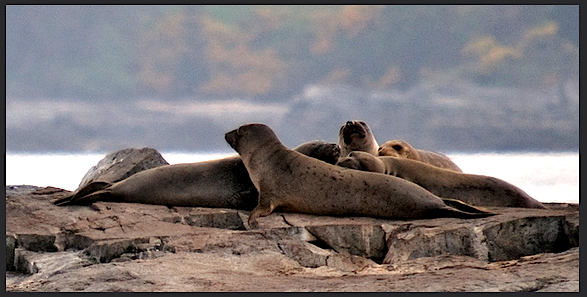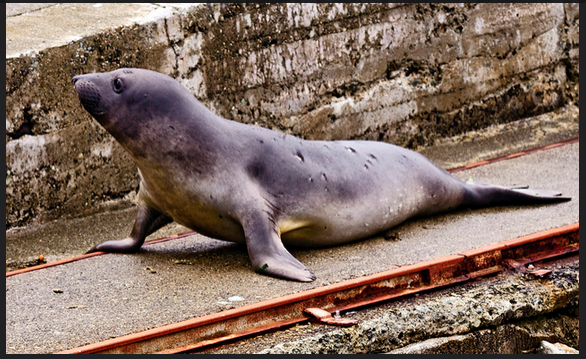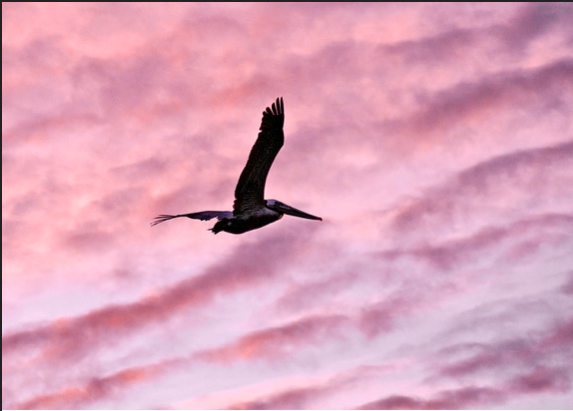-109, ‘2010-06-14’, ‘Elephant Seal’, 1, ‘Misery is hauled up between the path and the desalinator bunker, a change from the grassy area west of the boathouse. He is now almost finished his moult and seems to be much more docile these days. He was observed vocalizing loudly this afternoon -perhaps at a seagull that decided to stare him down on the path). The young female #4252 -soon to be named) has been observed hauled up on the island lately -didn ”t see her today). She ”s been making almost daily trips to the water from the grassy area near the boathouse -compared to Misery who decides to haul his girth down to the water only when the temperature becomes unbearable for his copious amounts of body mass). #4252 seems much more nervous than other elephant seals, perhaps because she is younger and is not as acquainted with our human presence on the island as compared to the other Mirounga. I have not seen Bertha around for a number of days now, and I ”ve not seen Slash since my return to the island two weeks ago. ‘, ‘adam’, ’22:20:14 ,
Tag Archives: tagged
Elephant seal behaviour
-106, ‘2010-06-03’, ‘Elephant Seal’, 3, ‘An eventful day for the elephant seals. More sunlight and less wind than we ”ve been used to this spring brought all three Elephant Seals on Great Race down to the water… but not before Misery had a go at mounting Bertha. She escaped up the “steep ” path to the grass on top of the foundation left from the original keeper’s house. Bertha then slipped past the sleeping Misery and lay on the ramp right at the water line in the shade but not in the water. Misery woke and detected the deception and came barreling down the path and boat ramp. Bertha took off through the water like a startled harbour seal, moving closer to the hauled-out California sea lions. She did not come back on land until dark. After all his effort, Misery followed just until he was in the water and took to splashing water back across his body which both trickled and steamed off his late winter coat. Once refreshed, he moved further into the water, floating and steaming in the warm sunshine. Seeing/smelling Bertha in deeper waters, he followed her only to have her swim even further away. 4252 was already in the water and Misery soon sensed her and tried to pin her against the rocks in the shallow sea lion haul-out, but she snapped at him and also swam to deeper waters. Just before sunset, Misery returned to land, trumpeting in the shallows. Looking at records -and noting how much girth Misery has put on lately), the habitat use of our two adult bull elephant seals is very different. Misery: showed up for the ”season ” first in October, was back before Slash showed up for the pupping season, stayed longer through the breeding season, and is now here moulting -as he did this time last year). His moult is delayed 1-2 weeks compared to last year. That all said, Misery has grown significantly this season after spending much of the last 6 months here at Race Rocks, while our dominant bull spends much greater times away before returning with added mass.’, ‘ryan’, ’23:56:01 ,
Elephant seal intrigue
Black Oystercatchers are the species of the day with the first chicks sighted in the nest to the E of the Main Keeper’s house. Camera 1 will just be able to make them out if they stay put. Another nest was discovered directly behind tank #1 that is a “limited-time only” infrastructure feature on the island. 3 nests with eggs:3,2,3 (now 2+chicks,2,3), 2 brooding pairs with undiscovered nests, and 2 pairs with overlapping feeding territories but no suspected nest sites.
Elephant Seal: 3
An eventful day for the elephant seals. More sunlight and less wind than we’ve been used to this spring brought all three Elephant Seals on Great Race down to the water… but not before Misery had a go at mounting Bertha. She escaped up the “steep” path to the grass on top of the foundation left from the original keeper’s house. Bertha then slipped past the sleeping Misery and lay on the ramp right at the water line in the shade but not in the water. Misery woke and detected the deception and came barreling down the path and boat ramp. Bertha took off through the water like a startled harbour seal, moving closer to the hauled-out California sea lions. She did not come back on land until dark. After all his effort, Misery followed just until he was in the water and took to splashing water back across his body which both trickled and steamed off his late winter coat. Once refreshed, he moved further into the water, floating and steaming in the warm sunshine. Seeing/smelling Bertha in deeper waters, he followed her only to have her swim even further away. El seal tagged#4252 was already in the water and Misery soon sensed her and tried to pin her against the rocks in the shallow sea lion haul-out, but she snapped at him and also swam to deeper waters. Just before sunset, Misery returned to land, trumpeting in the shallows. Looking at records (and noting how much girth Misery has put on lately), the habitat use of our two adult bull elephant seals is very different. Misery: showed up for the ‘season’ first in October, was back before Slash showed up for the pupping season, stayed longer through the breeding season, and is now here moulting (as he did this time last year). His moult is delayed 1-2 weeks compared to last year. That all said, Misery has grown significantly this season after spending much of the last 6 months here at Race Rocks, while our dominant bull spends much greater times away before returning with added mass.
Female elephant seals on Middle rock
 Elephant seals spend much of their lives in solitude as they travel great distances around the Pacific. At Race Rocks, we see congregations of elephant seals for the breeding season (late January) with most seals staying through to the end of their moults in late May. Here, elephant seals (adult and juvenile, male and female) begin to scout around the area at the end of October. This year females arrived first and left before the males arrived. I observed two size classes of elephant seal cows: the large breeding females, and the 3 to 5 year juveniles. The cows generally sort themselves by size with larger females bullying/harassing the smaller females.
Elephant seals spend much of their lives in solitude as they travel great distances around the Pacific. At Race Rocks, we see congregations of elephant seals for the breeding season (late January) with most seals staying through to the end of their moults in late May. Here, elephant seals (adult and juvenile, male and female) begin to scout around the area at the end of October. This year females arrived first and left before the males arrived. I observed two size classes of elephant seal cows: the large breeding females, and the 3 to 5 year juveniles. The cows generally sort themselves by size with larger females bullying/harassing the smaller females.
This is X201/X202 a tagged elephant seal cow whose first recorded visit to Race Rocks was October 2009. She has completed her moult but is still hanging around the reserve. Of the 10+ cows now in the reserve, she stands out as being the only one to routinely travel back and forth between the group on Middle Race Rocks and Great Race Island. She generally spends less than a week here on the main island, then 1-2 days with the others before returning. This last time, Bertha (the cow who pups here on Great Race) followed her within minutes.
Oystercatcher’s territory
‘Elephant Seal’, 5, ‘Fewer females are visible on Middle Rocks. The tagged female has returned to Great Race Island despite having completed her moult. The larger females on Middle Rocks are in various stages of their moults.’, ‘Ryan’, ’20:56:43 ,
-93, ‘2010-05-12’,
‘The diversity of bird life continues to increase with the appearance of
Dunlins, Brandts and Pacific Loons today.
Small groups of Brandts flew West throughout the day, followed by several large flocks numbering up to 100 birds in the evening.
A mature Brown pelican roosted here for the night, much to the gulls ” dissatisfaction.
There are still 2 pairs of Harlequin ducks spending their days around Great Race Island, plus
4 Whimbrels were again seen on the SW corner of the island where up to
3 Black Oystercatcher pairs have staked nesting territories. There are a total of
7 pairs of Oystercatchers with territories on the island, but only 2 confirmed nests so far, and of those only one nest with 2 eggs at the moment. Could be a bumper year as a maximum of 5 breeding Oystercatcher pairs have been recorded in the past. ‘,
‘Northern Sea Lion’, 10, ‘The numbers of Northern Sea Lions have been down the past several days, however they are still finding food in the reserve. A commotion right above the tidal turbine today attracted a number of gulls, and I could soon see a Northern sea lion was thrashing a large fish on the surface. Reviewing my photos it turns out the sea lion had captured a wolf eel! Long tasty filets on those protected fish, I can ”t say I ”m not envious!’,
‘Ryan’, ’21:10:38 ,
Diversity of Bird Life
‘The diversity of bird life has increased greatly with the improving weather this week. Rock sandpipers, Western sandpipers, Red Knots, and Greater Yellowlegs have all been seen in the intertidal zone. Yesterday evening a juvenile brown pelican spent a number of hours on Great Race before heading towards Port Angeles just after sunset. Today around noon a peregrine falcon zipped by Great Race and scared most of the small bird species away for the day. The Black Oystercatchers are becoming very territorial with one another, and the nest above the cove on the E side of Great Race now has 2 eggs.’, ‘Ryan’, ’17:42:48 ,
Mammal census:
‘Elephant Seal’, 8, ‘8 females remain on Middle Rocks, still in various stages of their moults. The tagged female X201/X202 recently left Great Race Island after completing her moult, but was photographed yesterday on Middle Rocks with the other females. This year is a pattern reversal compared to last year when it was the sub-adult male -Misery) who completed his moult on Great Race and few if any female elephant seals were seen here during this time.’, ‘Ryan’, ’17:45:02 ,
Elephant seals at 5 in number on Great Race Rocks
’2009-11-11′, ‘Elephant Seal’, 5, ‘First I have to apologize, I have been entering a lot of observations lately under the”Marine Life” category, and either this isn’t a public heading or all those entries have been lost to cyberspace.Recap:For the last week there have been 3 intermediate-sized elephant seal cows staying together near the boat house. One has rear flipper tags X201 and X202. The other two animals are a bit smaller than her. They alternate between an ever-rearranging sleeping pile to swimming around together in the shallows around the boat ramp. I have photos and footage of both. One of the smaller female’s right eye is milky/bluish, much like Slash’s bad eye. They are most often hauled out, but were swimming together as recently as yesterday morning. A fourth cow, this one a large adult was spotted yesterday hauled out on the intertidal island on the SE corner of the island. She has a distinctive bite scar on her lower back on the right side. She was observed this morning in the tidal channel partially submerged, facing the incoming water. As the tide reached a certain level she swam off. At the same time, a fifth large cow was observed in the shallows on the W side of the jetty. I photographed her smelling the air with her head raised out of the water, and I believe from that perspective she would have been able to see the smaller 3 by the boat house. However, there was no direct path that she could take and she eventually left. The only route elephant seals can take to access the majority of the island is the boat ramp on the E side of the jetty. This fifth cow had a distinctive long scar on the back right of her head/neck. I don’t know if there was this much elephant seal activity last year. I believe 5 females may be the most observed on Great Race Island on record.’, ‘Ryan’, ’11:45:09 ,
Ninene the Elephant Seal pup Returns to Vancouver Island April 15, 2009
What a pleasant surprize to see little Ninene this afternoon down in front of my home on Taylor Beach on Southern Vancouver Island. She has come through a load of problems and remarkably has made it this far. She was born on Race Rocks on January 30, 2009. Was weaned four weeks later when her mother left, was then badly beaten up by a young aggressive male, who was then driven off by Slash an older male, possibly her father, then she stayed on Race Rocks alone until March 30 without feeding, She then left Race Rocks on March 30, and arrived in Port Angeles on April 7, was moved from downtown to Ediz Hook Coastguard station. and then disappeared the next day. She showed up at 2 and a half months age on Taylor Beach in Metchosin , Southern Vancouver Island. In the past few weeks has traveled well over 50 kilometres.
When she was banded and observed in Washington, several researchers there believed that Ninene did not gain as much weight with her mother as she should have, so she is considered to be underweight for her age. So at this point she still is in a vulnerable situation and we hope she is able to forage well and put on more weight very soon. Ninene stayed only for the day and night. Hse was gone the next day, and we have never seen her since (as of 2014)
Elephant seal tangled
TEMPERATURE: Max. 4c >> >> Min 2c >> >> Reset 4c >> >> Rain none
MARINELIFE: Lots of Elephant Seal action today with one in the west bay and one on the slipway. Took lots of video. One on Centre Rock is still tangled in line. Two mature and one immature Bald Eagles here in the morning. Still three pairs of geese.
HUMAN INTERACTION: One ecotour boat and a short visit from Second Nature to drop off supplies. An airplane flew over the MPA at a fairly low (500 ft?) altitude and circled the MPA three times.
posted by Angus Matthews at 9:25 PM















